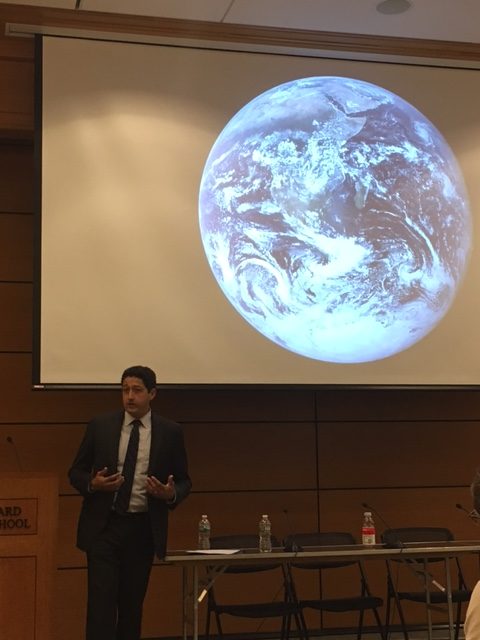By: Lindsay Bailey
The closing speaker at the LIDS Fall Symposium on Technology and Development was NASA’s chief of staff (and Harvard alumnus), Michael French. French spoke about NASA’s plan to get people to Mars by 2030 and the connection between NASA’s work and international development.
At first, the connection between NASA and international development may seem tenuous. Surely, instead of spending millions sending spacecraft to Mars we could be investing in education, infrastructure, or agriculture in developing countries? Surely space travel is pretty far down on Maslow’s hierarchy of human needs? Michael outlined three main reasons why NASA and development go hand in hand:
- Technical Assistance– NASA provides direct technical assistance to developing countries. For example, SERVIR is a joint project between NASA and the United States Agency for International Development (USAID) that gives developing countries the tools and the skills to use data from space in their decision making. We all know that accurate data, paired with analysis, can lead to better policy implementation. SERVIR gives developing countries access to earth science data from NASA’s satellites. The SERVIR program also provides training on how to use that data in disaster relief, water management, climate change mitigation, food security, agriculture, and land use. SERVIR is currently in over 30 countries in Africa, Hindu Kush-Himalaya, Lower Mekong, and Mesoamerica.
- Technology Transfer– Since it’s inception, NASA has been at the forefront of technological innovation. To work well in space, technology needs to be durable, easy to fix, and easy to use. When NASA invents something that works well in space, it’s probably going to work well even in the toughest of situations back on Earth. For example, when astronauts need to have their eyes checked they don’t have an ophthalmologist on the shuttle ready to do a check-up. NASA had to invent a reliable testing system that could be used by anyone. This same machine is now being used in the Himalayas to check people’s eyes in villages that an ophthalmologist is unlikely to visit. NASA has also developed a water purification system that is being used in India and Mexico after natural disasters. NASA has also tried to make sure this technology is available to everyone through low rates for government licenses or free IP. For more information about NASA’s technology transfer program, see their website here.
- Soft Power– Since NASA is perceived to be more neutral than the DOD or State Department, they are welcome where the US government is not. They are seen as trying to expand human knowledge and make the world a better place. In their history, they have had over 4,000 international agreements with 120 different countries. Most astronauts notice the lack of borders in space, and there are 17 different countries on the International Space Station conducting experiments with 82 different countries. We need this kind of global collaboration to solve some of our most pressing problems, including climate change and the refugee crisis.
LIDS would like to thank Mr. French for his time and effort in speaking at our symposium!
About the guest blogger: Lindsay Bailey is a first-year law student from Huntsville, Canada. Before coming to Harvard, she spent three years working in Northern Ghana on evidence based policy making, property taxes, monitoring and evaluation, and other governance issues. Her interests include the rule of law, transitional justice, local government, and women’s rights.
Follow Harvard Law and International Development Society on Facebook and Twitter (@HarvardLIDS).

